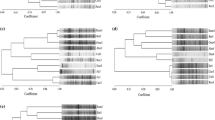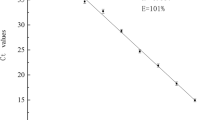Abstract
A real-time PCR approach was used in this study to clarify the populations of major bacterial species in the rumens of faunated and unfaunated cattle. The sensitivity of this novel real-time PCR assay was evaluated by using 101 to 108 plasmid copies of target bacteria. The numbers of plasmid copies of Ruminococcus albus, Ruminococcus flavefaciens, Prevotella ruminicola, and the CUR-E cluster were higher in the unfaunated than in the faunated rumens. The CUR-E cluster belongs to the Clostridium group. In contrast, Fibrobacter succinogenes was higher in the faunated than in the unfaunated rumens.
Although it is well known that an absence of protozoa brings about an increase in the bacterial population, it was clarified here that an absence of protozoa exerted differential effects on the populations of cellulolytic bacteria in cattle rumens (i.e., F. succinogenes, R. albus, and R. flavefaciens). In addition, real-time PCR analysis suggested that the CUR-E cluster was more prevalent in the unfaunated rumens.

Similar content being viewed by others
Literature Cited
Arakaki C, Mitsumori M, Itabashi H, Shirasaka S, Minato H (1995) Influence of the presence of protozoa on the rumen microbial population of cattle. J Gen Appl Microbiol 40:215–226
Caldwell DR, Bryant MP (1966) Medium without rumen fluid for nonselective enumeration and isolation of rumen bacteria. Appl Microbiol 14:794–801
Cotta MA (1988) Amylolytic activity of selected species of ruminal bacteria. Appl Environ Microbiol 54:772–776
Demeyer DI (1981) Rumen microbes and digestion of plant cell walls. Agric Environ 6:295–337
Forsberg CW, Cheng KJ, White BA (1997) Polysaccharide degradation in the rumen and large intestine. In: Mackie RI, White BA (eds) Gastrointestinal microbiology. New York: Chapman and Hall, pp 319–379
Kinoshita M, Imai S, Ishii T, Ogimoto K (1984) Functional morphology of the utilization of starch grain by rumen Entoniid ciliates in vitro. Jpn J Zootech Sci 55:846–876
Koike S, Kobayashi Y (2001) Development and use of competitive PCR assays for the rumen cellulolytic bacteria: Fibrobacter succinogenes, Ruminococcus albus and Ruminococcus flavefaciens. FEMS Microbial Lett 204:361–366
Kotarski SF, Waniska RD, Thurn KK (1992) Starch hydrolysis by the ruminal microflora. J Nutr 122:178–190
Orpin CG (1983) The role of ciliate protozoa and fungi in the rumen digestion of plant cell walls. Anim Feed Sci Technol 10:121–143
Ouwerkerk D, Klieve AV, Forster RJ (2002) Enumeration of Megasphaera elsdenii in rumen contents by real-time Taq nuclease assay. J Appl Microbiol 92:753–758
Ozutsumi Y, Tajima K, Takenaka A, Itabashi H (2005) The effect of protozoa on the composition of rumen bacteria in cattle using 16S rRNA gene clone libraries. Biosci Biotechnol Biochem 69:499–506
Stackebrandt E, Goebel BM (1994) Taxonomic notice: a place for DNA-DNA reassociation and 16S rDNA sequence analysis in the present species definition in bacteriology. Int J Syst Bacteriol 44:846–849
Tajima K, Aminov RI, Nagamine T, Matsui H, Nakamura M, Benno Y (2001) Diet-dependent shifts in the bacterial population of the rumen revealed with real-time PCR. Appl Environ Microbiol 67:2766–2774
Takenaka A, D’Silva CG, Kudo H, Itabashi H, Cheng KJ (1999) Molecular cloning, expression, and characterization of an endo-β-1, 4-glucanase cDNA from Epidinium caudatum. J Gen Appl Microbiol 45:57–61
Ushida K, Jouany JP, Demeyer DI (1991) Effects of presence or absence of rumen protozoa on the efficiency of utilization of concentrate and fibrous feeds. In: Tsuda T, Sasaki Y, Kawashima R (eds) Physiological aspects of digestion and metabolism in ruminants. New York: Academic Press, pp 625–654
Van Gylswyk NO (1990) Enumeration and presumptive identification of some functional groups of bacteria in the rumen of dairy cows fed grass silage-based diets. FEMS Microbiol Ecol 73:243–254
Williams AG, Coleman GS (1997) The rumen protozoa. In: Hobson PN, Stewart CS (eds) The rumen microbial ecosystem, 2nd ed. London: Chapman and Hall, pp 73–139
Acknowledgments
We would like to thank the staff and students at the Field Science Center of the Tokyo University of Agriculture and Technology for their help with the animal care and sampling.
Author information
Authors and Affiliations
Corresponding author
Rights and permissions
About this article
Cite this article
Ozutsumi, Y., Tajima, K., Takenaka, A. et al. Real-Time PCR Detection of the Effects of Protozoa on Rumen Bacteria in Cattle. Curr Microbiol 52, 158–162 (2006). https://doi.org/10.1007/s00284-005-0266-9
Received:
Accepted:
Published:
Issue Date:
DOI: https://doi.org/10.1007/s00284-005-0266-9




